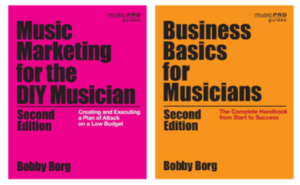Rehearsals are important to the functioning of every band. Rehearsals are where you craft your best songs and put together your most spectacular live performance sets.
But successful rehearsals require more than just making sure that all of the band members show up on time, come to the rehearsals prepared, and refrain from noodling on their instruments.
Foremost, successful rehearsals require important preliminary steps like ensuring that all the members share the right vision, making sure that clear goals are set, and discussing the dimensions of successful teamsmanship.
So, what follows is a complete discussion of all of these crucial issues, starting at the very beginning—the Band’s Vision. To close, I even have a surprise bonus section prepared for you. This is all stuff that you cannot afford to miss. So, what do you say we get right to it!
Discuss the Band’s Vision
Long before conducting your first band rehearsal, a band needs to make sure that all of its members are on the same page and that they share the same vision.
A vision represents where the group would like to see itself in three to five years.
A clear vision serves as a group’s guiding light and helps it to formulate a roadmap to success. A vision is what motivates each member and keeps everyone moving in the same direction—especially during long and tedious rehearsals in the early years where there may be no guarantee of a return on investment.
A vision is usually made up of the following elements:
• Style/Direction: What style of music does the band ultimately see itself playing?
• Revenue Generators: What products and services does the band see itself releasing?
• Level of Success: What strategic alliance is the band shooting for: major label, indie, or a DIY approach with a major-independent distributor?
• Values: What does the band stand for?
• Branding: What lasting vibe or attitude does the band see itself projecting onto the marketplace?
Without a general consensus of what everyone wants to achieve, a band is already starting off on the wrong foot.
Talking about a vision now helps ensure that everyone shares the same dream and reduces the possibility of members flaking out during rehearsals and even bailing ship on the band down the line. So talk about your vision today!
Set Goals, Break Down the Work,
Estimate the Schedule/Costs
Now that a band has a clear longer-term vision in place, it should start charting out a path to success. This requires forming shorter-term goals, breaking down the work required to achieve those goals, and estimating a schedule and costs. Doing this helps to identify any problems certain members may have with career planning/strategy, work ethic, finances and time.
Without uncovering these issues from the start, a band is quite likely to fail in conducting successful rehearsals when all of its members begin to metaphorically row the oars of the boat in opposite directions.
Here’s what a first draft schedule and estimate might look like for one year (divided into 4 quarters), with a grand total of the costs at the bottom.
Overall Goals
We will release a six-song debut EP, earn 100,000 Spotify Streams, play eight shows locally in various alternative venues, and build a social media following of 10,000 real Instagram fans.
Months 1–3 (Q1)
• Rent a rehearsal studio and meet four times a week.
• Write 15 songs and hone the band’s sound and direction.
• Demo the best compositions and get feedback.
• Define the band’s image and meet with a fashion consultant.
Months 4–6 (Q2)
• Complete an electronic press kit and build a professional website.
• Establish profiles on the most popular social media platforms
• Assign promotional responsibilities to each member.
• Book live performances locally and start building a database of fans.
Months 7–9 (Q3)
• Hire a songwriting coach and/or find a local producer.
• Pay to record our best songs professionally.
• Upload to all digital service providers and throw a release party
• Pitch playlists and bloggers for streams and reviews
Months 10–12 (Q4)
• Record a variety of music videos for upload to platforms like YouTube
• Attend and showcase at networking conferences and conventions.
• Pitch music libraries and pluggers for licensing opportunities.
• Make cool merch and try to generate some income.
• Total Projected Budget: $15,000 ÷ 4 = $3,750 per member
So there you have it. In addition to serving as a great organizational tool and a forecast of the work and costs yet to come, the above exercise is an excellent method for keeping everyone motivated. Make no mistake—it is difficult to run successful rehearsals if the members are unclear of the band’s path and purpose.
Talk About Teamsmanship
With vision and goals in place, a band must now understand teamsmanship. Without teamsmanship, I’m convinced that there is no way a band can hold successful rehearsals, complete its tasks and meet its goals (on time, on budget, and to the desired standard).
The elements necessary to run an effective team include the following:
Trust: The confidence that all members can express themselves freely and be heard without feeling exposed, vulnerable, and as though their ideas are not valued.
Healthy Conflict: The reassurance that all members can openly debate problems that are important to the band and focus on quick resolutions without letting interpersonal issues get in the way.
Commitment: A pact that each member of the band will commit to the organization and buy into the long-term vision, even when things might not always be precisely as “you” think they should be.
Accountability: A vow that all members will hold themselves and each other accountable for screwing up (like being late to rehearsals, making mistakes, having a bad attitude, etc.)
Collective Results: A pledge that all decisions will be made for the collective good of the band first, and not for the gain of an individual member.
The above standards are what help some of the world’s most successful organizations come together effectively and succeed—from professional sports teams to multinational companies. Hey, why can’t your band benefit, too. Right? Right!
START
REHEARSING
As previously stated, successful rehearsals require everything from band members showing up on time, coming to the rehearsals prepared, and refraining from noodling on their instruments. But there is so much more to rehearsals than meets the eye. Let’s take a closer look.
(Warning: In a Covid-19 world, please exercise all safety measures, like wearing masks and social distancing).
Decide on the Space
When a band, or just one member, is writing songs, it may not be necessary to have a full-size rehearsal space where you can set up a lot of equipment. Your home recording studio may be all you need. But in all other circumstances, there are essentially three rehearsal/writing options:
Lockouts: A lockout rehearsal room provides you 24-hour access and the luxury of keeping your gear set up, but you’ll need to supply your own PA, mixer, and microphones and be able to afford the monthly rent. You can find small affordable lockouts ranging from about $500 to $700 monthly.
Hourly Rooms: An hourly rehearsal room provides convenience to those who don’t want to commit to the monthly expense, but you’ll have to rehearse on the studio’s backline (drums, PA, and mixer) or otherwise drag in (and drag out) your own equipment. Hourly studios can run as cheap as $18 to $24 an hour.
Personal Space: Your personal rehearsal space (band’s rental house, parent’s house, etc.) affords many benefits. You have the luxury of keeping your gear set up, being surrounded by certain amenities (your kitchen, shower, backyard, etc.), and keeping a few more bucks in your pocket. However, you’ll likely experience noise problems with your neighbors, and you won’t have the liberty of rehearsing all night.
AFTERTHOUGHT: SHARING COSTS
Rob Danson of the band Death to Anders reminds us that when getting a lockout studio, you can pair up with another band to share the rental costs. You’ll probably have to move your gear off to the side on your nights off, but that is a small price to pay.
Make the Call
Once you’ve done your Google searches and you’ve decided on the rehearsal room that’s best for you, it’s time to make a list of available places in your area and make the call. Consider the following:
Ask for Referrals: Ask fellow artists you trust to recommend the most affordable and secure rehearsal spots in your town.
Check Local Music Mags: Flip to the back pages of your local music magazine or entertainment paper and you’ll find plenty of ads for rehearsal rooms. In Los Angeles you’ll discover services like Sound Arena, Downtown Rehearsal, and Swing House Studios. Of course, you can check out Music Connection’s annual directory of Rehearsal Studios: musicconnec tion.com/industry-contacts/
Call a Realtor: If you’re interested in renting a band house where you can all live and rehearse, check the yellow pages online to find a realtor near you who can help.
With phone number in hand, contact these companies and specifically ask about their services (hourly or lockout), security measures, and costs. Ask them whether their fees include air conditioning/heating in their rooms and adequate parking.
When speaking with a realtor about renting a house, ask her to focus on more secluded residential areas of your town so that you can get away with playing louder and longer.
Schedule Rehearsals and Meetings
Now that you have your rehearsal space in order, you need a specific practice schedule. Examine the personal schedules of all involved to consider the most convenient times and days, and then schedule three to four sessions a week, leaving a day or two off in between to avoid burnout.
If you schedule a rehearsal on a weekend night, consider ending it early so that members have time to catch other bands’ performances, to network, promote upcoming shows, and simply have some free time for fun (after all, you are human).s
Rehearse Before the Rehearsal
Whatever the objective for your next rehearsal session, remember this priority rehearsal tip: do your homework! It can save time and money, and prevent unnecessary tension.
Nothing is more unproductive than sitting around for an hour while a member figures out the chord changes to a song that could have been figured out at home. It’s disrespectful to the fellow band members who came prepared, and it’s a waste of your rent money, too.
Don’t Show Up Late
Time is valuable—especially when you’re shelling out precious rehearsal fees—so be sure to show up early for scheduled rehearsals.
If you have pedal boards, double bass pedals, or keyboard stands to set up (as you may when renting a studio by the hour), don’t spend the first 30 minutes of rehearsal doing so. Set up your gear in pieces outside of the room in the hallway or parking lot, and then move it all into place upon your allocated time. This way you can immediately get started with your rehearsal.
No Noodling Around In Between Songs
Here’s another time saver, courtesy of Rick King of Wall of Voodoo: “There’s nothing more distracting, unproductive, and annoying than a member noodling around in between songs when others are trying to work out parts. Everyone must remain focused on the same agenda at all times.”
I agree totally! There’s a time to practice rudiments and scales, and there’s a time to sit still and keep quiet.
Rehearse with a Click
Perhaps the best rehearsal tip I can offer is to use a click track. Whether you’re rehearsing for a live performance or for a recording session, rehearsing with a click can train you to “hold back” during live performances when you’re all pumped up from the crowd. It can also prepare you for recording sessions, where consistency of tempo from the beginning to the end of a song is crucial.
Record Your Rehearsals
Rehearsals should be recorded to help uncover where tempos are pushing or pulling, where song arrangements are working or not working, and where set orders are flowing or not flowing.
A portable digital recorder is really all you need to get the job done. Just place it in a section of the room where you can capture the best sound, hit record, and verbally title the recording (e.g., New Song #1, Set List A, etc.).
Appoint a band member to review the recording, take notes, and report back to the band at the next rehearsal with needed improvements and suggestions. If you want to feel like you’re really making progress, this tip is one of the most important to remember.
Hold Sectionals
Breaking up your rehearsals into different groups can help to isolate certain areas of concern and to remedy problems. For instance, the drummer and bassist can work on sections where the meter may be pushing and pulling, and the lead vocalist and background singer can tighten up harmonies.
Stephen Perkins, drummer for Jane’s Addiction, notes that his band often holds sectionals without vocalist Perry Farrell. Says Perkins, “Without vocal cues to rely on, you really learn to communicate well as a rhythm section. Furthermore, it gives Perry an opportunity to rest his voice. Be sure to add sectionals to your rehearsal schedule. You’ll be so much more productive.”
AFTERTHOUGHT: PRACTICE LIKE IT’S LIVE
Andrew Trout of Abandon Ship! reminds us to also rehearse the live performance aspect (choreography, what the singer is going to say between songs, etc.), and to get it on video for further study. It will really improve your live gigs.
Bring Spare Supplies
As we approach the end of our discussion on rehearsal tips, let’s discuss spare parts.
To avoid having to end your next rehearsal long before due, drummers and percussionists should carry extra snare heads and sticks, guitarists and bass players should carry extra strings and amp chords, and vocalists should bring a spare mic.
The last thing you want to do is spend your valuable rehearsal time racing around to find the nearest music store. Enough said!
Determine Your Guest Policy
A band must determine whether it wants its rehearsal sessions to be kept private or open to friends and family.
In the company of friends, you can run new sets and get immediate feedback. In private settings, you can work up new songs and arrangements without feeling pressured to entertain.
A possible solution: go for the best of both worlds. Schedule one evening of the week where friends can drop by at a specified time, and leave the other days of the week closed to your friends. But, whatever you do, determine a policy! Simply allowing friends to drop by as they wish will lead to unproductive sessions.
To Party or Not to Party?
And finally, for my last rehearsal tip, I suggest you create a party policy. Seriously! Hey, I’m not advocating this stuff, but beer and pot are nearly synonymous with a rock & roll lifestyle.
Says producer-singer-songwriter Raphael Saadiq, “If passing around a joint before rehearsal gets everyone in the vibe to create like it does for me, then do as you will. But if certain members are known to lose focus and to get goofy, save the partying for later. There is a time for play, and a time for work. So please keep your priorities straight.”
Check out Bobby's Borg's books, Music Marketing for The DIY Musician and Business Basics For Musicians, both in their Second Editions (2020). You can purchase the books and also sign up for his weekly free blog “Borg’s Blog” by visiting bobbyborg.com.
















